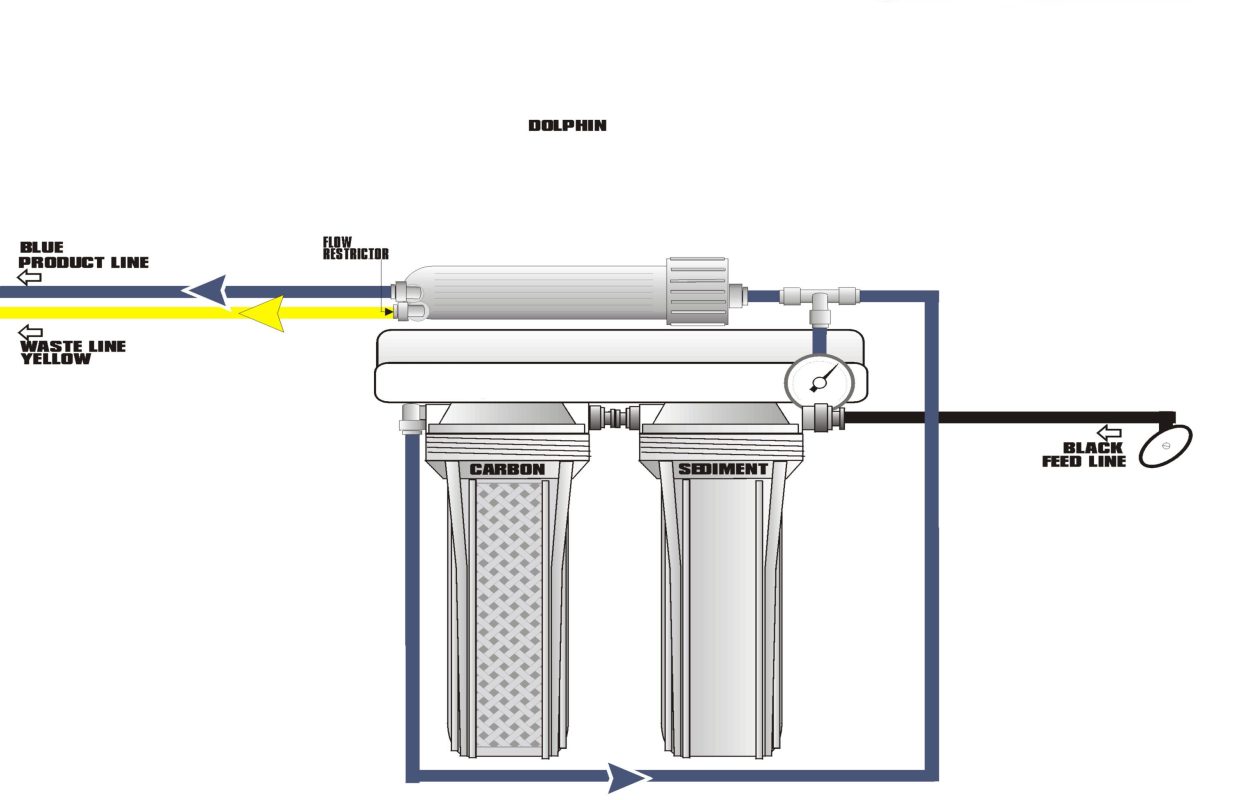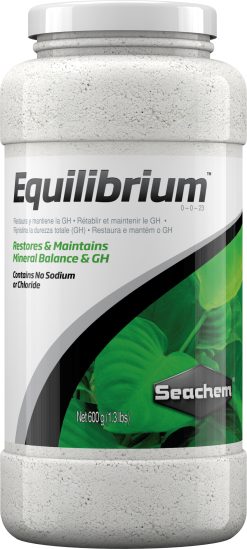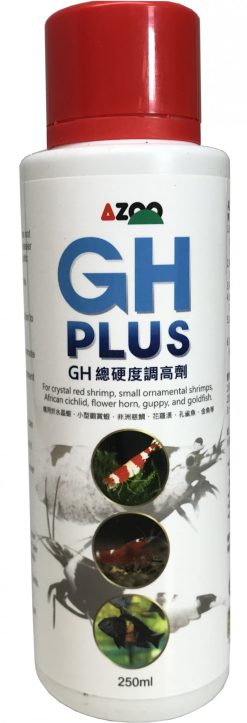The following Reverse Osmosis RO guide will cover everything needed to purchase, set up, troubleshoot, and implement RO in your aquascaping setup or saltwater reef aquarium.
Why do you need an RO filter?
Most natural tropical waters have a water hardness of GH 4-5. US water hardness differs from county to county in each state, but many places have hard water (GH 15-25 or more).
Suppose you live in an area with hard water, have a well, are not satisfied with the tap water quality, or are planning to have a saltwater fish tank; you will need an RO filter or RO water purchased from your local store. The RO abbreviation stands for Reverse Osmosis. This relatively simple technology does not require electricity. It uses the tap water pressure to push the H2O (water) molecules through a membrane that will let virtually nothing else through. After some treatment, you will use this clean, purified water in your aquarium. Besides the clean water outlet, there is another wastewater outlet hose on the device. This will drain hard water containing all the salts extracted from the source water and the exterior of the filter membrane. Place this hose in your sink or drain and never use this water in your aquarium.
There are also pre-filters in your RO device. These eliminate chlorine, heavy metals, and other physical contamination.
The maximum yield of an RO filter is calculated at 77 degrees Fahrenheit and a tap water pressure of around 59 psi. This means that your RO filter will almost certainly produce less than what it is rated for because the tap water temperature is usually much lower – around 50-60 degrees – and water pressure rarely exceeds 30- 40 psi. So the rating on your RO unit will not represent how much water you will have. With a 100-gallon per day unit, you will usually have more than enough purified water with time. You can also buy a booster pump to increase water pressure and efficiency.
The different kinds of RO filters
RO filters are usually categorized by their efficiency. Generally, cheaper filters are less efficient and produce less water per hour than their more expensive counterparts.
In our experience, an RO filter with just one membrane is usually sufficient. The aquaLife RO units are the best quality and contain high-quality Reverse osmosis membranes made in the US. aqualife

The main parts of an RO filter

1. Tap fitting. The RO filters usually come with a 3/4″ external thread or hose fitting. If you do not have a tap with 3/4″ outer thread, you must visit a local plumbing store and purchase the necessary fitting converters (you can also get a tee fitting, for example).
2. The tap water inlet hose is connected to the tap fitting element. This hose will lead into the first pre-filter. This will indicate which hose connects to the tap (source) water.
3. After the first pre-filtration step, the water will usually flow through an activated carbon filter. This will remove all chemical contaminants, such as chlorine and heavy metals. The pre-filters will have to be replaced regularly (every six months) to protect your membrane. Pre-filters are a lot cheaper to change than the membrane. If your water has high chlorine, you are advised to change pre-filters more often due to their limited capacity for chlorine removal.
4. The pre-filtered water will then go to the membrane housing. The lifespan of RO membranes is usually 3-8 years if the pre-filters are regularly replaced. Neglected pre-filters will drastically reduce the RO membrane lifespan. Keep the membrane moist if you are not using the RO filter for longer durations. Drying out will also mean the end of the membrane’s life.
6. The membrane housing has two hose exits. One of them will produce the purified water used in your aquarium. The other will make wastewater, leaving the membrane housing, and must be run to the sink or drain.
8. There usually is a flow restrictor (little white cylinder) on the wastewater hose. Its function is to limit the flow on this hose and improve the efficiency of the RO filter.
9. On larger RO filters, there is a bypass on the flow restrictor. The bypass has a smaller tap. If you open that tap, the system will rinse itself and clean the membrane surface. When the system flushes itself (the tap is open), you will see a stronger jet of water coming out from the wastewater line. This tap should be closed for regular operation (the wastewater flow should be weak).
Read More: Planted Aquarium Iron Q&A
Setting up an RO filter
The RO unit can be mounted on a wall. Make sure you operate the device in a room (bathroom, appliance room, or garage.) where potential leakage will not cause damage.
Connect the tap hose adapter of the osmosis system to a 3/4″ tap (cold water tap!). Ensure that the rubber seal fits securely.
Place the residual water hose and, initially, the osmosis water hose in the drain (a sink, bathtub, shower, or toilet). Open the tap water carefully (not the whole way) and check all joints,
connections, and filter containers for potential leakage. Make sure everything is watertight. In the event of a leakage, stop the water and fasten the joint by pushing the hose deeper into the joint or by attaching the filter hoses.
Allow the system to run for 2-3 hours to rinse away the preservative in the membrane. During this period, do NOT use the osmosis water. Discard this water. If your device has a bypass tap, you should open that after two hours and wait another 15 minutes for the RO membrane to be cleaned from the exterior. You can close the bypass tap at this point, and the osmosis water can now be collected and used.
Recommendation: The osmosis water reservoir should have a safety overflow to channel the water into a drain. This will enable you to prevent “flooding” should you forget to turn off the system in time. If you place your reservoir into the bathtub or shower, you will also be safe in case of overflows. Kits are available with a float and shutoff valve to turn the units off when the desired water level is reached in a storage container.
Read More: Aquarium Botanicals: Alder Cones
How much RO water does a device produce, and how to use RO filters?
Quality RO filters will remove 95%-99% of the Ca, Mg, Na, and other salts, as well as nitrate, phosphate, chlorine, heavy metals, and other chemical elements contained in the tap water. The clean water produced will be very soft and virtually free of harmful substances. The quality of the water can be measured with GH (total hardness) or KH (carbonate hardness) liquid tests or with our preferred digital conductivity (TDS) meters. Some larger RO units have TDS built into them. You can add one as well.
RO water is very pure and therefore contains practically no hardness, which is necessary to buffer the pH value. For this reason, osmosis water should always be set to the required hardness in the aquarium before use. The ideal water parameters for a planted “Nature Aquarium” are a GH of 6 (TDS meters will show around 130). You will set the water hardness and mineral content precisely according to the needs of your aquarium fish, shrimp, and plants with a GH raiser (GH plus). It is quick and easy with the right product.
Other reference water parameters: discus fish: 3-5 GH (1-3 KH), tropical planted aquarium 4-7 GH (2-4 KH), Malawi cichlids 3-6 GH (5-8 KH), Tanganyika cichlids 8-12 GH (16-18 KH).
Water hardness categories: soft water has a GH of less than 7. Medium hardness: GH 7-14, hard water: GH 14-21, very hard water has a GH of more than 21.
Seawater: If you are creating a Saltwater Aquarium, use only Premium Synthetic Sea Salts such as Fritz RPM or Aquavitro Salinity (Aquavitro is sold only in local stores or via phone order)
-
 Replenish 500ml$6.81
Replenish 500ml$6.81 -
 Equilibrium 600gm$13.64
Equilibrium 600gm$13.64 -
 GH Plus for Shrimp Tanks – 250 ml$15.21
GH Plus for Shrimp Tanks – 250 ml$15.21 -
 Mineral Plus for Shrimp Tanks – 120 ml$10.49
Mineral Plus for Shrimp Tanks – 120 ml$10.49
RO Care & Maintenance
We recommend using the system at least once a week for 30 minutes. If the system has not been used for more than two weeks, the osmosis water should be drained for approximately 1/4 hour before being used again. This will flush out any bacteria that may have gotten into the system. If the system is not used for extended periods, please ensure that the membrane is kept from drying out. To this end, it is advisable to plug the hose ends for the osmosis and residual water with a rubber stopper.
Most RO filters are virtually maintenance-free. To ensure a long membrane life, it is essential to remove the residues that build up on any osmosis membrane over time through regular rinsing. If the membrane is not rinsed regularly, a limey surface will become deposited on the membrane surface, resulting in diminished performance and premature system failure. Flushing the system with the bypass tap (A) is recommended. If your RO filter does not have a tap, close the water inflow, unscrew the coupling ring from the upper fitting of the flow restrictor (B), remove the flow restrictor, and extract the hose insert (little white cylinder) (C) from the end of the hose (to make sure it is not going to be rinsed out with the water into the sink) and open the tap. Rinse times depend on water hardness:
If tap water is soft (below GH 7), rinse time is 15 minutes every three weeks. With medium hardness (GH 7-14), it is 15 minutes every second week; with hard water (GH 14-21), it is weekly 15 minutes; with very hard water (above GH 21), it is 5-10 minutes after every usage.
Read More: CS Pro Flake Calanus & Spirulina Food
When should the membrane be replaced? Membranes should be replaced after 3-8 years – depending on usage – providing you have installed a good quality membrane such as those sold by aquaLife. If the clean water quality or the efficiency of the RO filter deteriorates, you will know it is time to replace the membrane. Remember that regular pre-filter replacements and rinsing will prolong your membrane’s lifespan.
Water quality can be determined by measuring the clean water GH or TDS values. The membrane should be replaced when the conductivity or hardness of the osmosis water is greater than 25 % of the tap water, or the amount of the produced osmosis water drops below 70% of the original amount (you have to take note of that when first using your RO filter), despite otherwise correct use (temperature, pressure, filter not blocked). Before measuring these values, the device should have been rinsed for 15 minutes and have been in operation for at least two hours.
Replacing the membrane. The top of the membrane container lid can only be unscrewed with a unique plastic tool, a spanner. A spanner is a round tool with a handle that should be found in the RO filter box. Please do not throw it out and keep it in a safe location for later use. Remember to store the new membrane under moist conditions (this is why it comes in a sealed plastic bag). Never let it dry out!
Please do not open or damage the plastic bag before installing the membrane because it will be difficult to seal it back airtight. Carefully remove the membrane using a pair of pliers. Lightly grease the two O-ring seals on the new osmosis membrane with Magic Lube. Insert the membrane (the two O-rings first) into the membrane container as far as it will go. Likewise, lightly grease the O-ring for the membrane container lid with Magic Lube. Screw on the container lid tightly and reconnect the hose with the hose insert.
Replacing the fine filter. You will notice if the fine filter is blocked because the flow rate will decline significantly. Release the hose screws on the membrane container lid. Turn on the tap and measure the volume of water flowing out of the outlet of the fine filter: Replace the fine filter. The fine filter should generally be replaced one to 4 times per year, more often in case of poor water quality.
Replacing the active carbon pre-filter. The active carbon filter should be replaced once to 4 times per year, in case of heavily chlorinated tap water – that smells of chlorine – every 3-4 months. Some active carbon filters may release fine particles that will clog the fine filter or pre-filter, so it is advisable to remove the membrane and rinse the system without it for 30 minutes, avoiding dust settling on the membrane or fine-filters. This is not needed with the aquaLife RO units.
Read More: Aquarium Botanicals: Organic Mulberry Leaves
General tips and troubleshooting for RO Units
In case of a leak, find the water source and fasten the screw or the fitting. DO NOT screw the fittings too tight, as you may damage the thread. Do NOT unscrew fittings once they are under pressure. All container lids have a rubber o-ring seal inside them; you might have to replace them occasionally or use Magic Lube for maintenance.
Troubleshooting
1. Too little reverse osmosis water and too little wastewater. The fine filter is clogged, one of the hoses is bent, or the tap water pressure has dropped. Replace the fine filter, check the hoses for breaks, or check the tap water pressure (it should be at least 3 bars or 44 psi). In case of low water pressure, use a booster pump.
2. Too little osmosis water but a normal amount of wastewater is produced. The membrane has aged or clogged, the rinsing tap has been left open, or the tap water is too cold. Rinse the membrane for 15 minutes, close the bypass valve or connect the system to a faucet that you can adjust to mix the cold water with hot water (make sure the water is not warm!).
3. A normal amount of osmosis water but too little wastewater. The flow restrictor is clogged, or the wastewater hosing is broken/clogged. Replace the flow restrictor and check the hoses.
4. The system leaks between the fittings and the container. Carefully screw the fitting in a further half to single turn. You must reseal the fitting using Teflon tape if that does not fix the leak.
5. The system leaks between the hose and the fitting. Unscrew the coupling ring, extract the hose and check whether the hose end has been cut off evenly and the hose insert is in place. Insert the hose into the fitting with the hose inserted as far as it will go (!), and tighten the coupling ring by hand. If the hose connection leaks, carefully tighten the coupling ring slightly using a tool. It is vital that you hold the fitting in place while doing so.
6. The system leaks at the membrane container lid. Release the hose connector and unscrew the lid. Check whether the O-ring is properly in place or is cracked, and, if necessary, install a new O-ring. Grease the O-ring lightly with Vaseline and tightly replace the container lid. Reconnect the hose.
Read More: Aquarium Botanicals: Guava Leaves
Central Water Purification System Instead of RO Filter
Many customers have told us that they do not need an RO filter because they have a professional, very expensive water softener installed centrally in their house or office. Our answer is always: No, don’t use it. These do not use the reverse osmosis principle. They will filter out heavy metals and chlorine. However, they use another salt (usually sodium salts) in higher amounts to “replace” calcium and magnesium salts in the tap water.
This is OK to drink and good for your home appliances, but our experience shows that it is bad for your aquarium (The TDS jumps up to 400-600 in water produced by these units). If it uses salt, you would be better off using tap water with aquaLife Complete or connecting the RO filter before the central system.
Read More: The Hidden Benefits of Almond Leaves
Summary
Using an RO filter is easy if you follow the instructions. Most users will install it and use it for many years without problems. If you feel apprehensive about installing one, you can always purchase one and call a plumber to set it up. RO filters do not take up much space. They can even be fitted in a kitchen cabinet with a small pressure tank and a drinking water spigot for the RO water (with overflow). Alternatively, water can be purchased from better aquarium stores. Remember to mineralize your water based on the needs of the aquarium.
